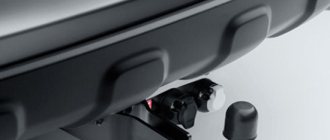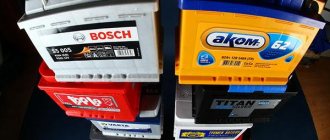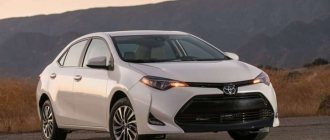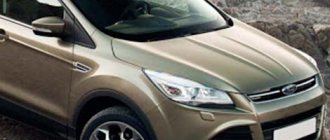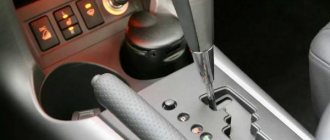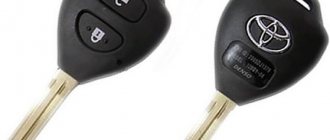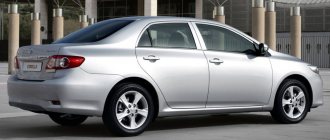One of the most popular cars in the comfort class is the famous Toyota Corolla, which has already experienced eleven incredible generational changes, a lot of restyling, engine changes, peripheral equipment and interior features. During its existence, the car has changed several body types, moving from the sports class to the popular segment. This is an incredible car that reflects an entire era of development of the Toyota Corporation. It’s quite difficult to say what exactly makes the car so popular today - it’s a standard C-class sedan with a good appearance and proven technology, but there’s nothing grand about the design or external characteristics of the Corolla. However, the car gained popularity due to its universal fame and a significant number of fans who have been driving only this car for many years.
The assembly of the Toyota Corolla for the manufacturer has become the central issue of the update. It became unprofitable to continue assembling cars in Japan, in the city of Takaoka. More precisely, the company would have to greatly raise the price of cars in Russia. This would clearly have a negative impact on the popularity of the car and its sales potential. Therefore, the eleventh generation Corolla moved to another production facility of the Japanese corporation. But this is not the Russian plant in St. Petersburg, which today has also significantly increased the corporation’s assembly assets and maintains prices for Toyotas in the Russian domestic market. So today we will look at the features of the Corolla assembly.
Where is Toyota Corolla assembled?
The question of where the car is assembled is always very important for car enthusiasts. It's not just a matter of pride in manufacturing in a well-designed, high-quality factory, but also confidence in the car. That is, by owning a car that was assembled by specialists from Takaoko, Corolla drivers were completely confident that the car would not let them down. Buyers left positive reviews already on the second day of use. But today the car is assembled in Turkey, at the official assembly plant of the corporation. And owners are in no hurry to voice reviews of the new Corolla so early, assessing all the features of the car. Among the features of the Turkish assembly, it is worth mentioning the following features:
- complete renewal of equipment on the assembly line for the production of Toyota Corolla;
- global investment in the company to move the assembly of such an important model for the company;
- Japanese management, all engineers making decisions came from Japan;
- training of staff with mandatory internship at a Japanese plant, full specialization;
- maximum compliance with assembly quality, mandatory certification of each stage of production;
- testing cars to identify any manufacturing defects.
In Turkey, only large-scale assembly, welding and painting of the car is performed. They also carry out anti-corrosion protection and other important processes to extend the life of the car. The company's employees are trained personnel who know perfectly well how to behave in a given situation. It is for these reasons that the build quality has not suffered much in comparison with Takaoko. However, car buyers have become biased towards certain aspects of transport. We are talking not only about the build quality, but also about the reliability of the engine and peripheral parts. Here you cannot have any complaints about the Corolla, since the engine and all the equipment are supplied from Japan and are only assembled in Turkey.
In which countries are cars of previous releases assembled?
An important point that the manufacturer pays special attention to is that in terms of quality and structural reliability, it does not matter where Toyota Corolla cars are assembled; each car undergoes strict multi-stage control.
Until the mid-1990s, all modifications of this car were assembled for the European market on two assembly lines - Takaoka and Tsutsumi in Japan, and for the American market - in the United States. Since 1994, the Japanese automaker has opened two assembly plants in European countries, namely in England and Turkey, which began to produce cars for the European market.
The Toyota Corolla, produced at a plant in Turkey, was supplied to the domestic market until 2006, after which the Japanese company opened its own assembly line in the village of Shushary, near St. Petersburg, which produced the first model of the Camry sedan in 2007. The main purpose of the Russian plant is to produce Toyota Camry premium sedans, and the Turkish Corolla car produced in Sakarya was supplied to the Eastern European market, the Russian Federation and all CIS countries.
In addition to the above countries, the automaker has launched factories where Toyota Corolla is assembled in other regions, namely:
- in Asia in China, Malaysia, Taiwan, Pakistan, India;
- in South Africa in Africa;
- in Brazil and Venezuela in South America;
- In Canada.
You can determine whose factory or assembly a released car has by the identification number (VIN) printed on its body. Each country of origin has a specific letter code. For example, Japan is designated JT.
Main features of the 11th generation Toyota Corolla
In 2013, the corporation launched production and introduced the first copies of the new generation Corolla to the market. The eleventh generation has become really interesting in appearance, significantly ahead of its predecessor. Reviews from fans of futuristic technology and compliments from experts immediately poured in. But the change in appearance caused some concern, because restyling completely removed the purpose of the tenth generation - a family sedan. In this sense, the Corolla sold very well in Russia, but will the new sedan with an updated, foppish appearance provide the same sales? This question remains open today, because the popularity of the brand has changed a little. The main features of operating the 11th generation Corolla are as follows:
- the car drives very confidently, no road obstacles are afraid of it;
- thoughtful design makes the car comfortable for Russia;
- Toyota tolerates any temperature conditions outside without any difficulties;
- excellent implementation of internal space provides high ergonomics to the driver;
- very well-thought-out car controls convey driving pleasure;
- a variety of configurations will help you choose the optimal equipment for yourself;
- the optimal technical base remains reliable, thoughtful and comfortable.
This car overcomes any competition both technically and functionally. Modern representatives of the C-Class from Toyota turned out to be quite attractive in all aspects. It is worth looking at most of the successful cars in the segment to compare the Corolla with these cars and be pleasantly surprised. The machine is not only more productive, interesting in appearance and functional, but also costs significantly less. Today, the basic configuration of a Toyota Corolla will cost the buyer a rather modest amount - 759,000 rubles. With important additions for safety and comfort, a fairly good basic version will cost 800 thousand.
Why are factories scattered all over the world?
The manufacturer locates its factories around the world to reduce transportation costs. Otherwise, then supplies of the popular car would fall. But you cannot think that if a car comes from Turkey, then the car is bad.
All employees who work at the plant undergo training and internship in Japan. A well-known manufacturer will not give factories into the hands of unknown people, since he will immediately lose his prestige if even two hundred people complain about the recently purchased cars.
Build quality is constantly monitored. And each stage of production undergoes certification. A finished car is tested for several weeks before going on sale.
In Turkey, they only assemble the components, weld the body, insert the seats, and paint it. Work on the creation of automatic transmissions, engines, wheels is carried out only in Japan. Finished parts are delivered to Turkey. About 150,000 cars are assembled at the plant in this country every year.
Therefore, the build quality of the cars does not suffer. And prices remain low for consumers.
Technical characteristics of Toyota Corolla in 2015
In technical terms, Japanese cars are completely clear. In this regard, Corolla offers quite a large number of technical equipment. The base engine of the car remains from the 10th generation City version. This is a 1.33-liter power unit, which without a turbine is capable of achieving 99 horsepower and quite a dynamic ride for a Corolla. But in some situations, particularly highway overtaking, this engine is a little weak. Therefore, many will prefer a 1.6-liter unit with 122 horsepower or a top-end 1.8-liter engine with 140 horsepower. In general, the situation with technology is as follows:
- three power units from 99 to 140 horsepower - an excellent line-up for the Corolla;
- the base engine is available only with a manual, the most powerful - only with an automatic;
- For the average power unit, both manual and automatic transmissions are available;
- configurations greatly change the feeling of the ride and the technical potential of the car;
- the technological equipment has many options that are comfortable and necessary for the driver;
- Each car can be customized for yourself by equipping it with the necessary equipment;
- Additional equipment items can be purchased for money; there were a lot of these items.
Today you can enjoy a wonderful ride in a truly Japanese car, albeit in Turkish assembly, without any worries about quality. The car will help you understand all the features of modern transport, show you new developments by Toyota and delight you with its futuristic appearance. The design of Corolla has remained relevant and unexpected for two years now. It must be admitted that Toyota is doing quite well in sales. The car is sold very actively in Russia, thanks to its history and quite interesting technical characteristics. Detailed customer reviews about the car have also begun to appear, which further motivate buyers to give their preference to the Corolla. Watch a fascinating Toyota test drive:
Machine build quality
A large number of cars from the 80s. of the last century, imported into Russia, created the Corolla image of budget and reliable technology. But as production volumes increased and new markets were conquered, the quality of cars began to decline. Already in the early 2000s. There were comments regarding the quality of the paintwork.
The manufacturer's savings on sound insulation led to a decrease in glass thickness, which negatively affected acoustic comfort.
The main observations noted during the inspection of XII generation Corolla cars of Turkish assembly:
- thin metal on the roof and doors that can be dented by hand;
- poor quality of the central grille, which does not fit well into the bumper;
- different shades of plastic used for interior trim elements;
- damage to the fasteners of plastic panels during assembly (for example, the steering column cover);
- weak fixation of the center console;
- the use of glossy plastic in the finishing, which is covered with a grid of scratches.
On previous generations of Corolla, oil leakage was noted from the electric amplifier located in the column.
Some owners complained about play in the gas and brake pedals; when pressed, a loud knock was heard from under the instrument panel. However, the manufacturer did not recognize the defects as a malfunction and refused to carry out warranty repairs. But many cars have traveled 200 thousand km or more with similar comments. The oil leak and pedal knock did not progress and did not in any way affect the handling of the Corolla sedan.
Let's sum it up
A high-quality Japanese car may well be one of the best choices for your purchase. Be sure to take advantage of the offers of the Japanese corporation and make this car incredibly comfortable, convenient and successful for yourself. To do this, use the possibilities of individually equipping the car with additional options, so as not to regret in the future that you did not add a not so expensive, but very necessary option to your vehicle equipment. There is no need to worry about the Turkish assembly; the car fully meets all quality requirements, its assembly reliability has remained virtually unchanged. If you find negative reviews about the quality of the layout and assembly, they are more based on the preconceived opinions of potential buyers.
If you ask the owner of an 11th generation Toyota Corolla, he will tell you only positive impressions of using the car. But if you just ask a person after a test drive about his impressions, the answers may be different. In the end, a person may not like a test drive of the most expensive Mercedes or Infiniti. This is an individual matter, so feel free to buy a Corolla if you have such a desire. Use your own criteria to get the best vehicles on the market. What do you think of the Toyota Corolla?
Toyota Corolla is assembled in Turkey
On many forums, one question is often asked that interests Toyota Corolla fans. Netizens want to know where the Toyota Corolla, which goes to the markets of Russia and Ukraine, is assembled. Let's back up our thoughts with facts. The tenth generation of our model has been supplied to Ukraine for quite a long time. Deliveries officially started in 2011. But the 11th generation is even more interesting. Its large-scale and active production was launched at a special plant in Turkey. It is located in the city of Sakarya.
We started assembling the eleventh Corolla more than a year ago, on July 1, 2013. And this date can be considered the beginning of a new stage in the successful cooperation of the brand with Turkey. It is from the city of Sakarya that large deliveries of the model are already underway both to Russia and to its closest neighbor, Ukraine. Note that on the eve of the start of assembly at the Turkish plant of the eleventh generation Corolla, it was modernized. Thanks to this, in 2014 production volumes will reach 150 thousand copies.
Review of Toyota Corolla 1.4 16v VVT-i (2006)
Hello, I want to share with you my impressions of owning a 2006 Toyota Corolla sedan E12, built in Turkey. Engine 1.4 97 horses, 550,000 rub. The car was purchased new in February 2007. I'm a young man, so I didn't have many cars. Before the Corolla there was a VAZ 2106, this car pretty much sucked my blood, I bought it used, at that time it was five years old. Over the years of operation of the six, a cap was made. engine repair and all chassis rebuilt. Well, a lot of little things.
Over time, I realized that I made a mistake by buying a lot of things from a dealer for immodest money, but who knew, after all, the first new car. Engine protection cost 4500, alarm system Sherkhan 5 12000 with installation, fleecy floor mats 1500, I even bought wheels with alloy wheels there, studded continental ones for 30000.
When my colleagues at work found out that I bought a left-hand drive Corolla, made in Turkey, they all said in one voice: “you dunce, why did you buy it, sell it before it’s too late, it will all fall apart, but for that kind of money you could buy a Toyota allion." But the years have passed, the car is almost six years old, the mileage is 71,000, and it doesn’t even think about breaking down.
But still we had to face some problems. At the 40th thousand the steering rack began to knock. One expert I know said that it was her, although the service station said that everything was fine with the car, tech. I passed the inspection myself without any problems. At 57 thousand, the engine speed began to float when you coast at neutral speed, the range is somewhere from 1000 to 2000 revolutions. At the same time, no indicators were lit. I went to the service station and they ran a diagnostic test on me. She didn't reveal anything. Next, we washed the injectors and cleaned the throttle valve. Everything was black. They took 4,500 rubles for the work. They told me not to fill up with 95 gasoline anymore. After that, I tried driving at 92, I didn’t like it, my fingers were knocking, I went back to 95. So far the car is running smoothly, but I think again at 57 thousand km. About once every three months I change the low beam bulbs, to be honest I’m already tired of them, fortunately they change in a couple of minutes. The backlight of the emergency stop button has also burned out. Sometimes the signal does not work, mainly in cold weather. By the way, the battery is still original, also Turkish.
The starter didn't work once. But I know the reason. The fact is that when you start a car with auto start, the car cranks the starter for a few seconds after starting. The specialists said that the alarm is attached to the battery charge indicator, which is why there is such a problem. Yes, I myself noticed that when you start the car with the key, the indicator lights up for a few seconds, and only then goes out. I had to come to terms with this problem, and the starter is still working.
I changed the brake pads all around at the 37th thousand. I bought some other pads, already 71,000, but they don’t even think about wearing out. But some say that such pads can quickly ruin brake discs. Well, that's all the problems after 71,000 km. I service the car myself. The cabin filter is located behind the glove compartment and is easy to change. The air on two latches also changes without problems.
Equipment: two front electric windows, ABS, air conditioning, driver's seat height adjustment, steering wheel adjustable in two directions, electrically adjustable heated mirrors, heated seats, full-size spare tire, standard music.
The seats are not very comfortable; on a long journey, your butt gets tired and your back hurts. But maybe I just adjusted them incorrectly. The controls are in their places, only the seat heating buttons are covered by the gearshift knob; they are not very visible from the driver’s seat. The visibility is good, the outside mirrors are large. When turning right, the wide front pillar gets in the way; you have to lean over a little. My height is 168 cm, I can sit comfortably in the front, there is plenty of space. Passengers don't seem to complain about the lack of space in the back either. The trunk is basically large, but the hinges eat up a lot of space. The 1.4 engine is certainly weak, but it’s enough for the city. On the highway the car is rather weak, especially with the air conditioning on and with passengers. It is very difficult to overtake. I didn't really like the gearbox. The rear does not always turn on the first time. The first speed also does not always turn on clearly. Otherwise it seems good.
The brakes are good, ABS is always activated on time. Regarding sound insulation, I don’t even know what to write. I have no idea what it should ideally be like on a car for 550,000 rubles. Well, the noise of the wheels is very audible. And the engine can be heard when the speed is more than 3000 rpm.
I don’t really like the ventilation of the car; the windows quickly fog up. The rear side ones take a long time to come off and are always frozen in winter, especially on the highway. The stove operates noisily even in the second speed mode. In winter, down to minus 30 is generally warm, below 30 it’s already cool. The car warms up quickly, but the operating temperature is reached only when driving. When you stop, the temperature drops slightly.
The air conditioner also copes with its task up to plus 30, when it is higher, it is no longer so effective. The car's ground clearance is quite high.
Well, that seems to be all, thanks to everyone who made it through. Review for those who choose a used car. Hope it helps you. The car is very good, if you can find a non-killed copy, you will drive for a long time without problems.
By the way, I love reading about cars, climbing into auto clubs, after reading it my hair stands on end. There are all sorts of problems people have, and at low mileage. So in this class, the Toyota Corolla E12 is the best car. Bye everyone.
